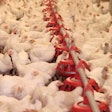Feed manufacturers are increasingly making use of a multi-phased buying strategy in their purchase of grains, according to European observers.
The main objective with phased buying is to spread purchases through the year rather than securing all annual grain requirements at once or in a few large batches. In this way, during these highly volatile times, the feed mill reduces the price risk associated with each purchase.
This is a response to the extra volatility of international commodity markets, along with other actions, such as diversifying the types of raw material used for rations and the number of sources from which ingredients are obtained.
A popular example of such a strategy is called the wedge, in reference to the shape that appears if a series of decreasing purchases is plotted on a graph. Such a wedge would be formed if, say, 20 percent of the annual requirement was bought in the first month and 15 percent in the second month, down progressively to only 5 percent each in months 10, 11 and 12.
European feed mills operating a wedge buying program are already placing part of their forward order for supplies up to the end of 2014.
It coincides with the widespread forging of closer ties between the grain trading organizations and feed manufacturing companies. The overall result may not be to everyone’s liking because it could mean less of the total grain supply being available for spot purchasing.Feed manufacturers are increasingly making use of a multi-phased buying strategy in their purchase of grains, according to European observers.
The main objective with phased buying is to spread purchases through the year rather than securing all annual grain requirements at once or in a few large batches. In this way, during these highly volatile times, the feed mill reduces the price risk associated with each purchase.
This is a response to the extra volatility of international commodity markets, along with other actions, such as diversifying the types of raw material used for rations and the number of sources from which ingredients are obtained.
A popular example of such a strategy is called the wedge, in reference to the shape that appears if a series of decreasing purchases is plotted on a graph. Such a wedge would be formed if, say, 20 percent of the annual requirement was bought in the first month and 15 percent in the second month, down progressively to only 5 percent each in months 10, 11 and 12.
European feed mills operating a wedge buying program are already placing part of their forward order for supplies up to the end of 2014.
It coincides with the widespread forging of closer ties between the grain trading organizations and feed manufacturing companies. The overall result may not be to everyone’s liking because it could mean less of the total grain supply being available for spot purchasing.
The main objective with phased buying is to spread purchases through the year rather than securing all annual grain requirements at once or in a few large batches. In this way, during these highly volatile times, the feed mill reduces the price risk associated with each purchase.
This is a response to the extra volatility of international commodity markets, along with other actions, such as diversifying the types of raw material used for rations and the number of sources from which ingredients are obtained.
A popular example of such a strategy is called the wedge, in reference to the shape that appears if a series of decreasing purchases is plotted on a graph. Such a wedge would be formed if, say, 20 percent of the annual requirement was bought in the first month and 15 percent in the second month, down progressively to only 5 percent each in months 10, 11 and 12.
European feed mills operating a wedge buying program are already placing part of their forward order for supplies up to the end of 2014.
It coincides with the widespread forging of closer ties between the grain trading organizations and feed manufacturing companies. The overall result may not be to everyone’s liking because it could mean less of the total grain supply being available for spot purchasing.Feed manufacturers are increasingly making use of a multi-phased buying strategy in their purchase of grains, according to European observers.
The main objective with phased buying is to spread purchases through the year rather than securing all annual grain requirements at once or in a few large batches. In this way, during these highly volatile times, the feed mill reduces the price risk associated with each purchase.
This is a response to the extra volatility of international commodity markets, along with other actions, such as diversifying the types of raw material used for rations and the number of sources from which ingredients are obtained.
A popular example of such a strategy is called the wedge, in reference to the shape that appears if a series of decreasing purchases is plotted on a graph. Such a wedge would be formed if, say, 20 percent of the annual requirement was bought in the first month and 15 percent in the second month, down progressively to only 5 percent each in months 10, 11 and 12.
European feed mills operating a wedge buying program are already placing part of their forward order for supplies up to the end of 2014.
It coincides with the widespread forging of closer ties between the grain trading organizations and feed manufacturing companies. The overall result may not be to everyone’s liking because it could mean less of the total grain supply being available for spot purchasing.

















